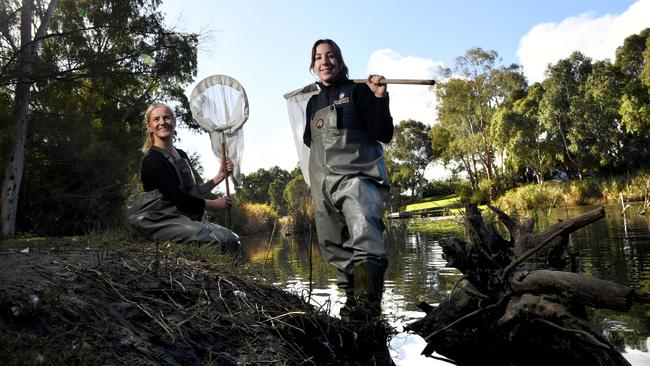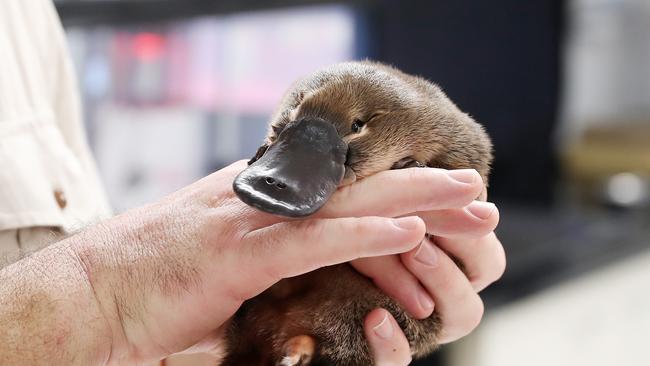Platypus reintroduction plan for Adelaide’s River Torrens in National Park City bid
They’ve been extinct in the wild on mainland SA since the 1970s – but now we could one day see platypus in the Torrens again.
SA News
Don't miss out on the headlines from SA News. Followed categories will be added to My News.
Platypuses are poised to make a comeback in the River Torrens as part of Adelaide’s bid to become a National Park City.
Green Adelaide will lead a scoping study with relevant organisations, researchers and councils to explore the possibility of bringing them back to the waterway.
Environment Minister David Speirs said the idea had been little more than a dream for more than 20 years but that was about to change.
“The River Torrens has come a long way, and with today’s improved native vegetation and water quality, it is the right time to progress this exciting project to hopefully make this dream a reality,” he said.
Adelaide Lord Mayor Sandy Verschoor said the project was an investment in the future.
“The platypus is one of the world’s most unique and unusual animals and to be able to reintroduce this species to the Torrens would be a remarkable achievement,” she said.
“Returning platypuses back to the Torrens would create a number of tourism and economic opportunities for our city to enjoy.”
The platypus has been considered extinct on the mainland of South Australia since the mid-1970s, with unconfirmed sightings in the Riverland during the 1990s and in 2018. However they can be seen in captivity at the fully-fenced Warrawong Wildlife Sanctuary at Mylor.
They were also introduced to Kangaroo Island in the 1920s and can be seen at waterholes in the Rocky River region of Flinders Chase National Park.
Green Adelaide chairman Professor Chris Daniels said with the right habitat and management techniques, this threatened species could be reintroduced.
“The scoping study will help to identify areas along the River Torrens for potential reintroduction, population sources, and will involve a platypus-reintroduction risk analysis,” he said.
“We know that issues of Opera House (fishing) traps, pumps and animals like foxes are obstacles to a successful reintroduction … we’ll determine the best way forward.”
Prof Daniels said improving habitat for the platypus would benefit other species, such as long-necked turtles and the native water rats.

University of Adelaide mammologist Dr Jasmin Packer and her research team, including Eilish Thomas, study riverbank mammals such as rakali and bandicoots.
Dr Packer said the platypus was a missing vital part of the River Torrens’ ecosystem.
“The platypus was common in the River Torrens and probably other Greater Adelaide waterways until the late 1880s,” she said.
“Since then, there have been regular reports of platypus in the Onkaparinga and Sturt rivers, but we’re still looking forward to the day when someone shares photos or footage of these sightings.
“This potential reintroduction is a vital and exciting next step in continuing the improvement of the River Torrens we all love so much.”
Green Adelaide is engaging with potential partners on the scoping study, which is expected to take about six months to develop.
For now, Warrawong Wildlife Sanctuary at Mylor is the only place on mainland SA where visitors can see platypus.
Co-owner David Cobbold said he would be willing to collaborate for a win-win solution, given he has a well-established feral-proof sanctuary with a wetland that is capable of intensive platypus breeding.
“It’s a lovely idea, but the devil’s in the detail,” he said.
“You can take care of an ecosystem and the animals know what to do but … platypus are predated upon by cats and foxes … so unless you’re going to feral-proof the entire Torrens, what’s your plan? Like when the offspring get kicked out of one pond and have to cross ground to go to another one, how is it that you’re going to protect them? Constant vigilance?”

PLATYPUS PUSH IS JUST THE BEGINNING
If wildlife sightings were rated from 1-10, with 10 points being awarded for catching a glimpse of the most elusive animal, surely, platypus viewings would be up there with the best.
Those hoping to spot a platypus in SA now need to head off to Warrawong Wildlife Sanctuary in the Adelaide Hills, or Kangaroo Island’s Flinders Chase National Park.
But in future, if an ambitious plan comes to fruition, the mysterious monotremes could be seen dipping up and down on the surface of the River Torrens.
Green Adelaide is partnering with researchers to examine the feasibility of reintroducing platypuses into the heart of the city.
It would be no mean feat, given the animals are considered extinct in most of South Australia.
Work will first be needed to look at which areas of the Torrens might be favourable to the animals and their puggles, where their initial population could come from, and the threats towards a potential new cohort of the animals.
Australia’s mammal extinction record is woeful – the highest rate of any country in the world, according to the WWF (formerly the World Wildlife Fund).
Given that human activities have contributed to a large number of animal extinctions, it’s vital that we do all we can to right the wrongs of the past.
Rewilding, or reintroducing native animals that have disappeared in a local area, is one way we can do this – but it comes with major challenges.
Returning platypuses would bring various benefits for people, from the tourism opportunities it would spawn, to the simple joy of seeing an animal reappearing in the waterway where it was once common.
The moves to explore returning platypuses to the Torrens would also boost Greater Adelaide’s bid to become the world’s second National Park City, after London.
But more importantly, it would help serve the species’ intrinsic right to survive despite being up against the odds.
Visit adelaidenationalparkcity.org





